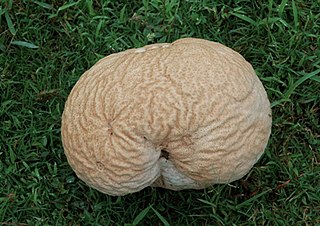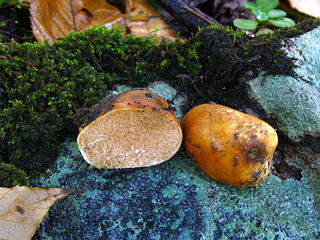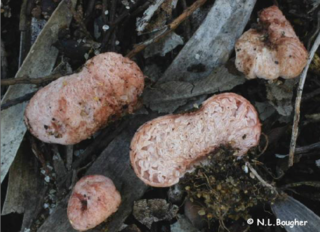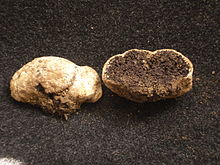
The Agaricales are an order of fungi in the division Basidiomycota. As originally conceived, the order contained all the agarics, but subsequent research has shown that not all agarics are closely related and some belong in other orders, such as the Russulales and Boletales. Conversely, DNA research has also shown that many non-agarics, including some of the clavarioid fungi and gasteroid fungi belong within the Agaricales. The order has 46 extant families, more than 400 genera, and over 25,000 described species, along with six extinct genera known only from the fossil record. Species in the Agaricales range from the familiar Agaricus bisporus and the deadly Amanita virosa to the coral-like Clavaria zollingeri and bracket-like Fistulina hepatica.

Calvatia is a genus of puffball mushrooms that includes the spectacular giant puffball C. gigantea. It was formerly classified within the now-obsolete order Lycoperdales, which, following a restructuring of fungal taxonomy brought about by molecular phylogeny, has been split; the puffballs, Calvatia spp. are now placed in the family Agaricaceae of the order Agaricales.

Rhizopogon villosulus is an ectomycorrhizal fungus used as a soil inoculant in agriculture and horticulture. It was first described scientifically by mycologist Sanford Myron Zeller in 1941.

Gautieria is a genus of hypogeal fungi in the family Gomphaceae. They form mycorrhizae with various tree species, mostly from the family Pinaceae. Species are present over much of the world's temperate and boreal forest habitats. It is well documented that species from this genera are an important part of the diet of the northern flying squirrel. Also, some Australian marsupials, especially the rat-kangaroos, feed extensively on these fungi. The fungi also benefit from this relationship: not only do the squirrels help to disperse the spores and propagate the species, studies suggest that passage through the digestive tract of a mammal promotes germination of spores.
Gasterellaceae is a family of fungi in the order Boletales. It contains the single genus Gasterella, which in turn contains the single species Gasterella luteophila, found in the USA. The genus and species was described by American mycologists Sanford Myron Zeller and Leva Belle Walker in 1935; the family by Zeller in 1948.
Protogastraceae is a family of fungi in the order Boletales that contains the single genus Protogaster. The genus in turn contains the single species Protogaster rhizophilus, found on the roots of Viola in the USA. The family was described by American mycologist Sanford Myron Zeller in 1934, the genus and species by Roland Thaxter.
Gelopellis is a genus of fungi in the family Claustulaceae. The species in this relatively rare genus have fruit bodies that resemble the unopened egg of Mutinus, with the columnella occupying the place where the compressed receptacle would be in the latter genus. The genus contains six species found in South America, Japan, and Australia.

The Broomeiaceae are a family of fungi in the order Agaricales. The family is monotypic, and contains the single genus Broomeia, described by English naturalist Miles Joseph Berkeley in 1844, and named for his collaborator, Christopher Edmund Broome. Berkeley designated the type species to be Broomeia congregata. Species of this fungus family can be found in Mexico as well as various parts of Africa.

Nemaxera is a genus of the fungus moth family, Tineidae. Therein, it belongs to the subfamily Nemapogoninae. The genus is considered monotypic, with the single species Nemaxera betulinella placed here.

Disciseda is a genus of gasteroid fungi in the family Agaricaceae. It is a widely distributed genus that is prevalent in arid zones. Disciseda was circumscribed by mycologist Vassiliĭ Matveievitch Czernajew in 1845.
Secotium is a genus of fungi in the family Agaricaceae. The members of this genus are closely related to ordinary Agaricus mushrooms, but do not open out in the usual way; this has given rise to the term "secotioid" for such mushrooms in general. They are thought to form an evolutionary link between agarics and gasteroid fungi. Secotium is a widespread genus, with species that are predominantly found in warm and arid regions.

Agaricus deserticola, commonly known as the gasteroid agaricus, is a species of fungus in the family Agaricaceae. Found only in southwestern and western North America, A. deserticola is adapted for growth in dry or semi-arid habitats. The fruit bodies are secotioid, meaning the spores are not forcibly discharged, and the cap does not fully expand. Unlike other Agaricus species, A. deserticola does not develop true gills, but rather a convoluted and networked system of spore-producing tissue called a gleba. When the partial veil breaks or pulls away from the stem or the cap splits radially, the blackish-brown gleba is exposed, which allows the spores to be dispersed.

Depressaria is a genus of moths in the superfamily Gelechioidea. It is the type genus of subfamily Depressariinae, which is often – particularly in older treatments – considered a distinct family Depressariidae or included in the Elachistidae, but actually seems to belong in the Oecophoridae.

Zelleromyces is a genus of fungi in the family Russulaceae. It was first described by mycologists Rolf Singer and Alexander H. Smith in 1960 to contain hypogeous (underground) fungi with gasteroid fruit bodies that "bleed" latex when they are cut.

Setchelliogaster is a genus of fungi in the order Agaricales. It is incertae sedis with respect to familial placement within the order, although Kirk and colleagues consider it likely aligned with either the Bolbitiaceae or the Cortinariaceae. Species Fungorum class it as in the Bolbitiaceae family. The genus is widespread in warm, dry areas, originally containing five species, later degraded to 3 species. It was circumscribed by Czech mycologist Zdeněk Pouzar in 1958.

Agonopterix is a moth genus of the superfamily Gelechioidea. It is placed in the family Depressariidae, which was often – particularly in older treatments – considered a subfamily of the Oecophoridae or included in the Elachistidae.

Morganella is a genus of puffball fungi in the family Agaricaceae. The genus name honors American botanist Andrew Price Morgan (1836–1907). The widely distributed genus is prevalent in tropical areas. A 2008 estimate placed nine species in Morganella, but several new species have since been described.

Hydnangium is a genus of truffle-like fungi in the family Hydnangiaceae. All species in this genus are known to form ectomycorrhizal associations with trees.














